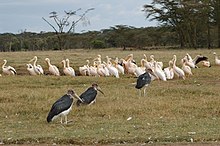Clade of birds
Pelecanimorphae is a clade of aequornithean birds that comprises the orders Ciconiiformes , Suliformes and Pelecaniformes .[ 3] [ 4] Pelecanimorphae is defined in the PhyloCode Pelecanus onocrotalus Sula leucogaster Ciconia ciconia [ 5] Pelecanes was named by Sangster et al, 2022 to unite Pelecaniformes and Suliformes and defined in the PhyloCode as the "least inclusive crown clade containing Pelecanus onocrotalus Sula leucogaster [ 5]
This cladogram follows the hypothesis that herons are sister to Pelecani. [ 6] [ 7]
References
^ Livezey, Bradley C.; Zusi, Richard L. (2007). "Higher-order phylogeny of modern birds (Theropoda, Aves: Neornithes) based on comparative anatomy. II. Analysis and discussion" . Zoological Journal of the Linnean Society . 149 (1): 1– 95. doi :10.1111/j.1096-3642.2006.00293.x PMC 2517308 PMID 18784798 . ^ Sangster, G.; Braun, E.L.; Johansson, U.S.; Kimball, R.T.; Mayr, G.; Suh, A. (2022). "Phylogenetic definitions for 25 higher-level clade names of birds" . Avian Research . 13 : 100027. Bibcode :2022AvRes..1300027S . doi :10.1016/j.avrs.2022.100027 ^ Jarvis, E.D.; et al. (2014). "Whole-genome analyses resolve early branches in the tree of life of modern birds" . Science . 346 (6215): 1320– 1331. Bibcode :2014Sci...346.1320J . doi :10.1126/science.1253451 . PMC 4405904 PMID 25504713 . ^ Prum, Richard O.; Berv, Jacob S.; Dornburg, Alex; Field, Daniel J.; Townsend, Jeffrey P.; Lemmon, Emily Moriarty; Lemmon, Alan R. (2015). "A comprehensive phylogeny of birds (Aves) using targeted next-generation DNA sequencing". Nature . 526 (7574): 569– 573. Bibcode :2015Natur.526..569P . doi :10.1038/nature15697 . ISSN 0028-0836 . PMID 26444237 . S2CID 205246158 . ^ a b Sangster, George; Braun, Edward L.; Johansson, Ulf S.; Kimball, Rebecca T.; Mayr, Gerald; Suh, Alexander (2022-01-01). "Phylogenetic definitions for 25 higher-level clade names of birds" (PDF) . Avian Research . 13 : 100027. Bibcode :2022AvRes..1300027S . doi :10.1016/j.avrs.2022.100027 ISSN 2053-7166 . ^ Reddy, S.; Kimball, R.T.; Pandey, A.; et al. (2017). "Why do phylogenomic data sets yield conflicting trees? Data type influences the avian tree of life more than taxon sampling" . Systematic Biology 66 (5): 857– 879. doi :10.1093/sysbio/syx041 PMID 28369655 . ^ Kuhl, H.; Frankl-Vilches, C.; Bakker, A.; et al. (2021). "An unbiased molecular approach using 3′-UTRs resolves the avian family-level tree of life" . Molecular Biology and Evolution . 38 (1): 108– 127. doi :10.1093/molbev/msaa191 PMC 7783168 PMID 32781465 .
